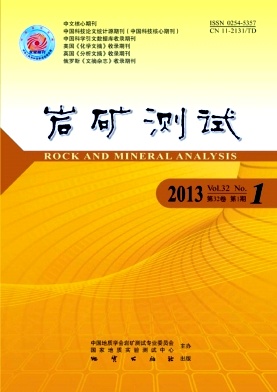| [1] |
EPA method 8260B, Volatile Organic Compounds by Gas Chromatography/Mass Spectrometry[S].
Google Scholar
|
| [2] |
李义,董建芳,张宇.地下水中挥发性有机物的吹扫捕集-气相色谱-质谱法测定[J].岩矿测试,2010,29(5): 513-517.
Google Scholar
|
| [3] |
左海英,张莉,张永涛,桂建业.挥发性有机物检测中内标法与外标法的比较[J].南水北调与水利科技,2009,7(4): 67-73.
Google Scholar
|
| [4] |
周密,刘德全,林旭,李少艾.吹扫捕集/气相色谱法测定空气中挥发性有机物[J].中国环境监测,2004,20(4): 12-14.
Google Scholar
|
| [5] |
黄健祥,胡玉玲,李攻科.选择性固相微萃取涂层的研究进展[J].分析科学学报,2008,24(1): 97-102.
Google Scholar
|
| [6] |
申书昌,宋文成,贾鹏禹.硅氧烷-聚氨酯共聚物的制备及其作为固相微萃取头涂层用于分离水中芳香族化合物[J].理化检验:化学分册,2010,46(12): 1444-1446.
Google Scholar
|
| [7] |
李晓晶,贺小平,黄聪,甘平胜,于鸿.固相微萃取-气相色谱法同时测定饮用水中27种有机磷农药[J]. 中国卫生检验杂志,2009,19(6): 1231-1233.
Google Scholar
|
| [8] |
秦宏兵,顾海东,孙欣阳,朱健禾.顶空固相微萃取-气相色谱法测定水中四乙基铅[J].中国环境监测,2012(4): 82-84.
Google Scholar
|
| [9] |
曾丹丹,陈宏,黄国方,廖建萌,罗林.固相微萃取技术在挥发性有机物分析中的应用研究进展[J].广东化工,2009,36(8): 315-316.
Google Scholar
|
| [10] |
李文超,王永花,孙成,杨绍贵.分子印迹技术与固相微萃取技术联用的研究进展[J].环境化学,2011,30(9): 1663-1671.
Google Scholar
|
| [11] |
刘静,曾兴宇,烟卫.自动顶空固相微萃取气相色谱法同步分析水中17种有机物[J].分析试验室,2012,29(12): 55-58.
Google Scholar
|
| [12] |
何小波,刘秀华,林涛.饮用水中氯仿和四氯化碳的顶空固相微萃取气相色谱测定法[J].环境与健康杂志,2010,27(7): 629-631.
Google Scholar
|
| [13] |
孔娜,邹小兵,黄锐,夏之宁,魏欣旸.微波辅助-顶空液相微萃取在线联用-高效液相色谱法测定环境水样中的敌敌畏[J].色谱,2010,28(12): 1200-1203.
Google Scholar
|
| [14] |
余胜兵,朱炳辉,许瑛华. 聚氯乙烯(PVC)管材中氯乙烯单体的溶解沉淀-顶空-气相色谱法测定[J].分析测试学报,2010,29(10): 1083-1086. doi: 10.3969/j.issn.1004-4957.2010.10.018
CrossRef Google Scholar
|
| [15] |
Huang S P, Huang S D. Determination of organochlorine pesticides in water using solvent cooling assisted dynamic hollow-fiber-supported headspace liquid-phase microextracrion [J].Journal of Chromatography A, 2007,1176: 19-25. doi: 10.1016/j.chroma.2007.10.073
CrossRef Google Scholar
|
| [16] |
Bordajandi L R, Ramosl J J, Sanz J, Gonzalez M J, Ramos L. Comprehensive two-dimensional gas chromato-graphy in the screening of persistent organohalogenated pollutants in environmental samples[J]. Journal of Chromatography A, 2008,1186: 312-324. doi: 10.1016/j.chroma.2007.12.013
CrossRef Google Scholar
|
| [17] |
唐巧玉,周毅峰.快速溶剂萃取法提取水芹中总黄酮工艺研究[J].食品科学,2010,31(22): 190-193.
Google Scholar
|
| [18] |
周延生, 王涵文,关亚风.加压溶剂萃取法萃取大气颗粒物中的烷烃[J].分析化学,2004,32(8): 983-987.
Google Scholar
|
| [19] |
陈云霞,游静,梁冰,王国俊.吹扫/捕集-热脱附气相色谱法研究吸附剂富集水中痕量挥发性有机物的效果[J].分析化学,27(10): 1186-1189. doi: 10.3321/j.issn:0253-3820.1999.10.017
CrossRef Google Scholar
|
| [20] |
左海英,桂建业,张琳.吹扫捕集-气相色谱/质谱联用测定水中30种挥发性有机物[J].南水北调与水利科技,2008,6(6): 81-83.
Google Scholar
|
| [21] |
郭永泽,张玉婷,李娜,刘磊,邵辉,李辉,程奕.农产品中多种农药残留的气相色谱-质谱联用法测定[J].分析测试学报,2010,29(12): 1186-1195. doi: 10.3969/j.issn.1004-4957.2010.12.013
CrossRef Google Scholar
|
| [22] |
章晴,邹积鑫,石高军.超高效液相色谱-质谱联用法与气相色谱-质谱联用法分析水性印油印记的主要成分[J].色谱,2010,28(12): 1132-1136.
Google Scholar
|






 DownLoad:
DownLoad: